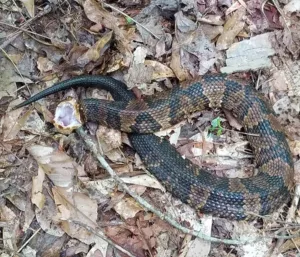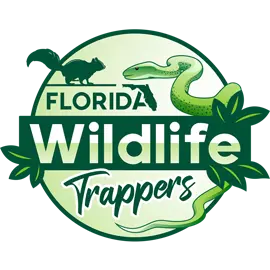Florida Brown Water Snake

Florida Water snake (Nerodia fasciata pictiventris): An In-Depth Look
The Florida Water snake (Nerodia fasciata pictiventris) is a non-venomous, semi-aquatic snake species native to the southeastern United States, particularly Florida. This snake belongs to the Colubridae family and is one of the many species of water snakes found in North America. Although often mistaken for the venomous cottonmouth (Agkistrodon piscivorus), the Florida Water snake is harmless to humans and plays a crucial role in maintaining the ecosystem.
Physical Characteristics
The Florida Water snake has a distinctive appearance that varies in coloration but typically exhibits a combination of gray, brown, or reddish hues with dark bands along its body. The patterning is more prominent in juveniles and fades with age. Some adults may appear almost entirely dark, making them even more likely to be misidentified as cottonmouths.
The underbelly of the Florida Water snake is typically lighter in color, often adorned with irregular blotches or half-moon shapes, which help differentiate it from similar species. These snakes can reach lengths of 24 to 55 inches (60 to 140 cm), with females generally growing larger than males.
As the name suggests, the Florida Water snake is found predominantly in Florida, but its range extends into parts of southern Georgia and Alabama. It thrives in a variety of freshwater habitats, including swamps, marshes, ponds, lakes, rivers, and canals. Unlike some aquatic snakes, this species does not rely solely on water; it can often be found basking on logs, rocks, or vegetation near the water’s edge.
Florida Water snakes prefer slow-moving or still waters with abundant vegetation, which provides ample hiding spots from predators and opportunities for hunting prey. They are well-adapted to both natural and man-made water bodies, making them a common sight in Florida’s diverse wetland environments.
Behavior and Temperament
Florida Water snakes are primarily diurnal, meaning they are most active during the day, although they may exhibit nocturnal tendencies in particularly hot weather. They are strong swimmers and spend much of their time hunting in and around the water.
Although non-venomous, these snakes can be defensive when threatened. If cornered or handled, they may flatten their bodies, emit a musky odor, or even bite in an attempt to ward off predators. Their bite, while not venomous, can be painful due to their sharp teeth. However, they prefer to flee rather than engage in confrontation, quickly retreating into the water if disturbed.
Diet and Hunting
Florida Water snakes are carnivorous and primarily feed on aquatic prey. Their diet consists mainly of fish, amphibians (such as frogs and salamanders), and occasionally small invertebrates. Unlike constrictors, these snakes capture their prey using a combination of ambush and active foraging strategies, swallowing their catch whole. Their strong swimming abilities and keen eyesight allow them to hunt effectively in their aquatic habitats.
Juvenile water snakes tend to consume smaller prey like tadpoles and insects before gradually transitioning to larger meals as they grow. This adaptability in diet helps them thrive in a variety of wetland ecosystems.
Reproduction and Lifespan
The Florida Water snake follows a viviparous mode of reproduction, meaning it gives birth to live young rather than laying eggs. Mating typically occurs in the spring, and females give birth in late summer or early fall. A single litter can contain anywhere from 10 to 30 young, depending on the size and health of the mother.
Newborn snakes are independent from birth and must fend for themselves immediately. They resemble miniature versions of the adults, complete with banded patterns that provide camouflage against predators. These young snakes grow rapidly and reach maturity in about two to three years.
In the wild, Florida Water snakes have an average lifespan of 8 to 10 years, though they can live longer in captivity when protected from natural predators and environmental hazards.
The food that they eat
Despite being formidable hunters, Florida Watersnakes have their own set of predators, including birds of prey (such as hawks and herons), larger snakes, raccoons, and alligators. Their natural camouflage helps them avoid detection, but they are still vulnerable to attacks, particularly when basking or moving between water sources.
Humans also pose a significant threat to these snakes. Habitat destruction, pollution, and road mortality are major concerns, as wetlands continue to be drained or developed. Additionally, Florida Watersnakes are often killed by people who mistake them for venomous species, highlighting the importance of education and conservation efforts.
Misidentification with Cottonmouths
One of the biggest challenges facing Florida Watersnakes is their frequent misidentification as cottonmouths. While both species share similar habitats and coloration, there are key differences:
Head Shape: Cottonmouths have a broad, triangular head, whereas Florida Watersnakes have a more slender, oval-shaped head.
Pupil Shape: Cottonmouths have vertical slit-like pupils, while Florida Watersnakes have round pupils.
Behavior:
Cottonmouths tend to stand their ground and may open their mouths in a defensive display, while watersnakes are more likely to flee.
Coloration: Cottonmouths often have a more solid, darker coloration, while watersnakes retain banded patterns, at least when younger.
Educating the public about these differences can help reduce unnecessary killings of Florida Watersnakes and promote coexistence with these beneficial reptiles.
Conservation Status
Currently, the Florida Watersnake is not considered endangered or threatened. It remains relatively abundant in its range, thanks to its adaptability to different freshwater environments. However, ongoing habitat loss and pollution could pose future risks to its population.
Conservation efforts for wetland preservation and public education about non-venomous snakes are vital in ensuring the continued survival of this species. Encouraging responsible wildlife interactions and reducing unnecessary fear-based killings can help maintain ecological balance.
Human Interactions and Importance in the Ecosystem
The Florida Watersnake plays a crucial role in its ecosystem by helping regulate populations of fish and amphibians. By controlling these populations, the snake contributes to the overall health and stability of wetland environments.
Despite their benefits, watersnakes are sometimes viewed as pests, especially when they inhabit areas near human dwellings. People often encounter them in backyard ponds or swimming areas, leading to unwarranted fear. In reality, these snakes are not aggressive unless provoked and serve as natural pest controllers by keeping aquatic prey populations in check.
The Florida Watersnake (Nerodia fasciata pictiventris) is a fascinating and ecologically important reptile native to the southeastern United States. With its adaptability, unique physical characteristics, and vital role in the food chain, it remains an integral part of Florida’s wetland ecosystems.
While often misunderstood and misidentified as venomous, these harmless snakes contribute significantly to maintaining balanced ecosystems. Through education, conservation efforts, and habitat preservation, we can ensure that the Florida Water snake continues to thrive in its natural environment for generations to come.

